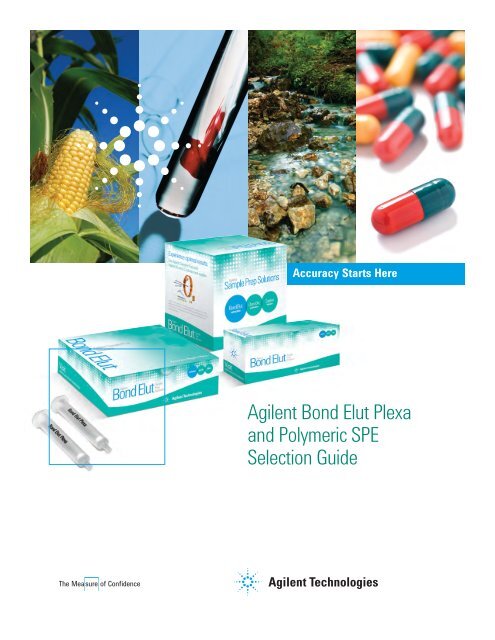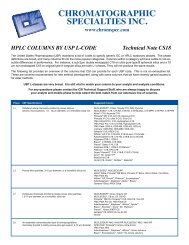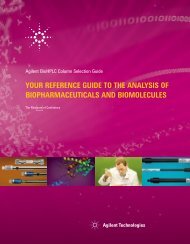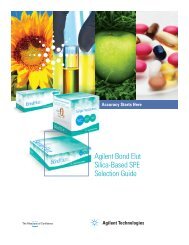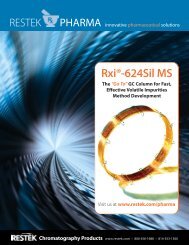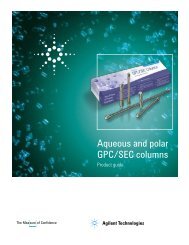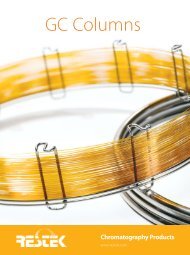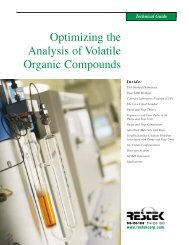Agilent Bond Elut Plexa and Polymeric SPE Selection Guide
Agilent Bond Elut Plexa and Polymeric SPE Selection Guide
Agilent Bond Elut Plexa and Polymeric SPE Selection Guide
You also want an ePaper? Increase the reach of your titles
YUMPU automatically turns print PDFs into web optimized ePapers that Google loves.
Accuracy Starts Here<br />
<strong>Agilent</strong> <strong>Bond</strong> <strong>Elut</strong> <strong>Plexa</strong><br />
<strong>and</strong> <strong>Polymeric</strong> <strong>SPE</strong><br />
<strong>Selection</strong> <strong>Guide</strong>
TABLE OF CONTENTS<br />
1 Solid Phase Extraction<br />
8 <strong>Bond</strong> <strong>Elut</strong> <strong>Plexa</strong><br />
17 Other <strong>Polymeric</strong> <strong>SPE</strong>
SOLID PHASE EXTRACTION (<strong>SPE</strong>)<br />
<strong>Agilent</strong> <strong>Bond</strong> <strong>Elut</strong>:<br />
Accuracy Starts Here<br />
For over 30 years, <strong>Bond</strong> <strong>Elut</strong> has been the most trusted name in solid phase extraction.<br />
Years of use by dem<strong>and</strong>ing chemists at top companies worldwide have thoroughly documented<br />
its many applications <strong>and</strong> proven its performance. To this day, you will find more literature<br />
references for <strong>Bond</strong> <strong>Elut</strong> than any other <strong>SPE</strong> product in the industry.<br />
<strong>Bond</strong> <strong>Elut</strong> is manufactured using state-of-the-art automation to guarantee quality <strong>and</strong><br />
consistency. Optical scanners installed throughout our automated assembly process inspect<br />
each <strong>Bond</strong> <strong>Elut</strong> tube at multiple points. And during manufacture, 25 different tests are<br />
conducted to ensure reproducibility. If an imperfection is spotted, the tube is removed from<br />
the assembly line. The result is consistently reliable <strong>Bond</strong> <strong>Elut</strong> cartridges, time <strong>and</strong> time again.<br />
Over 40 different sorbent functionalities are available in a variety of cartridge formats including<br />
straight barrel, large reservoir capacity (LRC) <strong>and</strong> <strong>Bond</strong> <strong>Elut</strong> Junior (Jr).<br />
THE BOND ELUT DIFFERENCE<br />
• Heritage of Reliability: With years of use in some of<br />
the most dem<strong>and</strong>ing analytical laboratories in the world,<br />
<strong>Bond</strong> <strong>Elut</strong> products have a proven track record resulting<br />
in a strong publication pedigree<br />
• Options for Your Needs: Offering extraction solutions<br />
for the widest range of analytes <strong>and</strong> matrices, with over<br />
40 bonded silica phases for high specificity methods<br />
<strong>and</strong> polymeric phases for rapid method development,<br />
<strong>Bond</strong> <strong>Elut</strong> has the largest choice of formats <strong>and</strong> sorbents<br />
in the market<br />
• Innovative Products Designed for Lab Efficiency:<br />
Whether it be fast flow polymeric particles or our<br />
patented 96-well plate design, all <strong>Bond</strong> <strong>Elut</strong> products<br />
are created for ease-of-use <strong>and</strong> flexibility to meet both<br />
manual <strong>and</strong> automated requirements<br />
• Technical Support at Every Step: For your specific<br />
applications, or to help solve occasional technical issues,<br />
a global team of analytical scientists is on h<strong>and</strong> to assist<br />
• World Class Manufacturing <strong>and</strong> Quality: Unrivaled<br />
manufacturing control, plus exacting ISO 9001: 2000<br />
compliant inspections guarantee the consistent quality<br />
of <strong>Bond</strong> <strong>Elut</strong><br />
WWW.AGIlEnt.cOm/chEm/SAmPlEPrEP
SOLID PHASE EXTRACTION (<strong>SPE</strong>)<br />
Diagrams are to scale<br />
SAMPLE PREPARATION FORMATS<br />
<strong>Agilent</strong> Offers the Broadest Range<br />
of Tube Formats <strong>and</strong> 96-well Plate Designs<br />
60 ml<br />
4 AGIlEnt BOnD ElUt PlExA AnD POlymErIc <strong>SPE</strong> SElEctIOn GUIDE<br />
We have a full set of straight barrel <strong>SPE</strong> tubes ranging from 1-150 ml<br />
in a wide range of bonded silica <strong>and</strong> polymeric chemistries, sorbent particle<br />
sizes <strong>and</strong> bed masses.<br />
For more specialized applications, the luer compatible <strong>Bond</strong> <strong>Elut</strong> Jr<br />
<strong>and</strong> the funnel-shaped large reservoir capacity (lrc) tube offer flexibility<br />
<strong>and</strong> function in a broad range of sorbent bed masses.<br />
20 ml<br />
12 ml
<strong>Bond</strong> <strong>Elut</strong> 96-well Plates<br />
<strong>Bond</strong> <strong>Elut</strong> 96-well plate formats are best in class for flow performance <strong>and</strong> well-to-well<br />
reproducibility. these specially designed plates are available with well depths of 1 ml<br />
<strong>and</strong> 2 ml <strong>and</strong> in a large range of different sorbent chemistries.<br />
VersaPlate<br />
VersaPlate is a highly innovative, flexible design that lets you customize plates.<br />
Insert different phases for sorbent screening or insert only enough tubes to match<br />
the number of samples to be extracted for minimal waste. VersaPlate can be<br />
purchased in a pre-packed format or as loose tubes.<br />
Packed Formats for Automation<br />
<strong>Bond</strong> <strong>Elut</strong> sorbents are also available in packed bed formats for automation platforms, such<br />
as the Spark holl<strong>and</strong> Symbiosis, Gilson A<strong>SPE</strong>c <strong>and</strong> Gerstel mPS systems. <strong>Agilent</strong>'s unique<br />
OmIx pipette format is also used with a wide range of liquid h<strong>and</strong>ling devices, ranging from<br />
h<strong>and</strong>-held pipettors to high-throughput automated systems.<br />
SOLID PHASE EXTRACTION (<strong>SPE</strong>)<br />
10 ml lrc 6 ml<br />
ml<br />
1 ml<br />
<strong>Bond</strong> <strong>Elut</strong> Jr<br />
WWW.AGIlEnt.cOm/chEm/SAmPlEPrEP<br />
5
SOLID PHASE EXTRACTION (<strong>SPE</strong>)<br />
CROSS REFERENCE OF COMPARABLE PHASES<br />
BY MANUFACTURER<br />
Different chemistries <strong>and</strong> manufacturing processes create sorbents that exhibit differences in selectivity, so there is no<br />
universal equalivent for every application. however, the performance of products can be similar in many applications.<br />
this table provides suggestions for using <strong>Agilent</strong> <strong>Bond</strong> <strong>Elut</strong> products in comparison to products from other manufacturers.<br />
Polymers<br />
If you are using... Try this...<br />
Phenomenex<br />
Strata<br />
Waters<br />
Oasis<br />
6 AGIlEnt BOnD ElUt PlExA AnD POlymErIc <strong>SPE</strong> SElEctIOn GUIDE<br />
Supelco<br />
Supelclean/Discovery<br />
<strong>Agilent</strong><br />
<strong>Bond</strong> <strong>Elut</strong><br />
Strata-x hlB <strong>Plexa</strong><br />
SDB-l EnVI-chromP EnV or lmS<br />
Strata-x-c mcx <strong>Plexa</strong> Pcx<br />
Strata-x-A mAx <strong>Plexa</strong> PAx<br />
Silica-Based <strong>and</strong> Other Sorbents<br />
If you are using... Try this...<br />
Phenomenex<br />
Strata<br />
Waters<br />
Sep-Pak<br />
Supelco<br />
Supelclean/Discovery<br />
<strong>Agilent</strong><br />
<strong>Bond</strong> <strong>Elut</strong><br />
c18-E tc18 EnVI-18, DSc-c18, lc-18 c18<br />
c18-U c18 c18 Oh<br />
c8 c8 DSc-8, Envi-8, lc-8 c8<br />
tc2 c2<br />
Phenyl (Ph) DSc-Ph, lc-Ph Ph<br />
Screen-c certify<br />
Si-1 Silica DSc-Si, lc-SI SI<br />
Fl-Pr Florisil lc <strong>and</strong> EnVI Florisil Fl<br />
nh2 Amino Propyl DSc-nh2, lc-nh nh2<br />
DSc-Diol, lc-Diol 2Oh<br />
cn cyano Propyl DSc-cn, lc-cn cn-U<br />
Alumina A, B, n lc-Alumina A, B, n Alumina A, B, n<br />
SAx AccellPlus QmA DSc-SAx, lc-SAx SAx<br />
Scx AccellPlus cm DSc-Scx, lc-Scx Scx<br />
EnVI-carb carbon<br />
EnVIcarb-II/nh2 carbon/nh2<br />
EnVIcarb-II/PSA carbon/PSA<br />
For Silica-Based <strong>SPE</strong> products, see the <strong>Agilent</strong> <strong>Bond</strong> <strong>Elut</strong> Silica-Based <strong>SPE</strong> <strong>Selection</strong> <strong>Guide</strong>, publication number 5990-859 En
Sorbent Specifications<br />
Sorbent<br />
Phase<br />
Category <strong>Bond</strong>ed Functional Group/Base Material Format Surface<br />
Area<br />
(m 2/g)<br />
Particle Size (µm)<br />
<strong>and</strong> Shape<br />
<strong>Plexa</strong> Polar enhanced hydrophilic styrene divinylbenzene Packed bed 550 45, spherical<br />
monodisperse<br />
<strong>Plexa</strong> Pcx cation mixed mode Scx functionalized hydrophilic styrene divinylbenzene Packed bed 550 45, spherical<br />
monodisperse<br />
<strong>Plexa</strong> PAx Anion mixed mode SAx functionalized hydrophilic styrene divinylbenzene Packed bed 550 45, spherical<br />
monodisperse<br />
Mean<br />
Pore Size<br />
(Å)<br />
PPl non-polar Functionalized styrene divinylbenzene Packed bed 600 125, spherical 150<br />
EnV non-polar Styrene divinylbenzene Packed bed 125, spherical 450<br />
lmS non-polar Styrene divinylbenzene Packed bed 75, spherical 00<br />
nExUS mixed mode mixed mode copolymer Packed bed 575 70, spherical 100/450<br />
Bimodal<br />
Sample Preparation Reference <strong>Guide</strong><br />
Product Typical Matrices Primary Extraction Mechanism Compound Types<br />
<strong>Bond</strong> <strong>Elut</strong> <strong>Plexa</strong> Plasma, urine, aqueous <strong>and</strong> biological fluids non-polar non-polar compounds with acidic/neutral<br />
fractionation<br />
PAhs from water<br />
<strong>Bond</strong> <strong>Elut</strong> <strong>Plexa</strong><br />
PAx<br />
<strong>Bond</strong> <strong>Elut</strong> <strong>Plexa</strong><br />
Pcx<br />
Plasma, urine, aqueous <strong>and</strong> biological fluids mixed mode: non-polar <strong>and</strong> anion exchange Acidic compounds, carboxylic acid<br />
metabolites of drugs, peptides<br />
<strong>and</strong> amino acids<br />
Plasma, urine, aqueous <strong>and</strong> biological fluids mixed mode: non-polar <strong>and</strong> cation exchange Basic drugs, basic drugs of abuse<br />
<strong>Bond</strong> <strong>Elut</strong> PPl Water sources, biological fluids non-polar, electrostatic non-polar compounds, phenols<br />
<strong>Bond</strong> <strong>Elut</strong> EnV Water sources non-polar Polar organic molecules, explosive residues<br />
<strong>Bond</strong> <strong>Elut</strong> lmS Urine, plasma, biological fluids non-polar non-polar compounds<br />
<strong>Bond</strong> <strong>Elut</strong> nExUS<br />
<strong>and</strong> <strong>Bond</strong> <strong>Elut</strong><br />
nExUS Wcx<br />
SOLID PHASE EXTRACTION (<strong>SPE</strong>)<br />
horse urine, urine, biological fluids non-polar Drugs of abuse, quaternary drugs,<br />
endocrine disruptors<br />
100<br />
100<br />
100<br />
WWW.AGIlEnt.cOm/chEm/SAmPlEPrEP<br />
7
BOND ELUT PLEXA<br />
<strong>Bond</strong> <strong>Elut</strong> <strong>Plexa</strong><br />
The <strong>Bond</strong> <strong>Elut</strong> <strong>Plexa</strong> Family is a new generation of polymeric <strong>SPE</strong> products, designed for simplicity,<br />
improved analytical performance <strong>and</strong> ease-of-use. Its uniqueness lies in the novel hydroxylated<br />
exterior, hydrophobic interior <strong>and</strong> advanced polymeric architecture.<br />
<strong>Bond</strong> <strong>Elut</strong> <strong>Plexa</strong><br />
<strong>Bond</strong> <strong>Elut</strong> <strong>Plexa</strong> is a non-polar divinylbenzene-based neutral polymeric sorbent. this sorbent is the best choice for non-ionic<br />
extraction of a wide range of acidic, neutral <strong>and</strong> basic analytes from different matrices.<br />
<strong>Bond</strong> <strong>Elut</strong> <strong>Plexa</strong> PCX<br />
<strong>Bond</strong> <strong>Elut</strong> <strong>Plexa</strong> Pcx is a cation exchanger with mixed mode sorbent characteristics <strong>and</strong> is therefore suitable for the extraction<br />
<strong>and</strong> cleanup of weak bases from biofluids. <strong>Bond</strong> <strong>Elut</strong> <strong>Plexa</strong> Pcx demonstrates the same excellent particle size distribution<br />
<strong>and</strong> integrity as <strong>Bond</strong> <strong>Elut</strong> <strong>Plexa</strong>. A highly controlled sulfonation process results in zero fines for <strong>Bond</strong> <strong>Elut</strong> <strong>Plexa</strong> Pcx.<br />
<strong>Bond</strong> <strong>Elut</strong> <strong>Plexa</strong> PAX<br />
<strong>Bond</strong> <strong>Elut</strong> <strong>Plexa</strong> PAx is based on the same innovative base polymer particle technology as the other members of the <strong>Plexa</strong> <strong>SPE</strong><br />
family. this advanced material offers excellent flow characteristics due to its monodisperse particle size distribution, affording<br />
superior ease-of-use, with minimal clogging of the packed bed. the amide-free particle technology does not provide binding<br />
sites for endogenous interferences such as proteins <strong>and</strong> lipids.<br />
8 AGIlEnt BOnD ElUt PlExA AnD POlymErIc <strong>SPE</strong> SElEctIOn GUIDE<br />
Tips & Tools<br />
Learn the core concepts surrounding Solid<br />
Phase Extraction <strong>and</strong> best practices for<br />
Sample Prep. View the video at<br />
www.agilent.com/chem/spevideo
Advanced Polymer Architecture Improves Extraction Performance<br />
LOAD: WASH: ELUTE:<br />
Water-rich, hydrophilic surface allows excellent phase<br />
transfer of analytes into the polymer core.<br />
Analyte<br />
Pores<br />
large endogenous proteins do not bind to the surface<br />
of the polymer <strong>and</strong> cannot access pore structure.<br />
Analytes that have crossed the hydrophilic layers<br />
will remain tightly bound in the hydrophobic core.<br />
Interferences wash away without leaching<br />
the analytes of interest.<br />
BOND ELUT PLEXA<br />
Specially engineered pore structure allows<br />
excellent mass transfer out of the polymer.<br />
clean extract with high recovery.<br />
WWW.AGIlEnt.cOm/chEm/SAmPlEPrEP<br />
9
BOND ELUT PLEXA<br />
GENERAL PROTOCOL FOR TROUBLE-FREE<br />
<strong>SPE</strong> APPLICATIONS WITH BOND ELUT PLEXA<br />
Regardless of your application or sample type, you will appreciate the difference the <strong>Bond</strong> <strong>Elut</strong> <strong>Plexa</strong> range makes. <strong>Plexa</strong> delivers simple methods, superior<br />
flow characteristics, <strong>and</strong> improved analytical performance, all leading to easier validation. Simple methods deliver clean extracts <strong>and</strong> high recoveries from<br />
a wide range of acidic, basic <strong>and</strong> neutral analytes. The advanced polymeric design effectively eliminates the common matrix interferences that cause ion<br />
suppression, resulting in improved analytical sensitivity <strong>and</strong> data quality.<br />
Analyte<br />
Sample Treatment<br />
Sorbent Condition<br />
Equilibrate<br />
Wash<br />
<strong>Elut</strong>ion 1<br />
<strong>Elut</strong>ion 2<br />
Log P > 1.0<br />
pKa < 5<br />
10 AGILENT BOND ELUT PLEXA AND POLYMERIC <strong>SPE</strong> SELECTION GUIDE<br />
Acids Neutrals Bases<br />
<strong>Plexa</strong> PAX<br />
2% NH 4OH<br />
100% MeOH<br />
100% H 2O<br />
100% H 2O<br />
100% MeOH<br />
Neutrals<br />
5% HCO 2H in MeOH<br />
Acids<br />
Log P > 1.5<br />
pKa 3-6<br />
pKa 6-10<br />
<strong>Plexa</strong> Acid Load<br />
Method<br />
<strong>Plexa</strong> Base Load<br />
Method<br />
1% HCO 2H 2% NH 4OH<br />
100% MeOH<br />
100% H 2O<br />
5% MeOH in H 2O<br />
100% MeOH<br />
Neutrals<br />
Log P > 0.8<br />
pKa 6-10<br />
<strong>Plexa</strong> PCX<br />
2% H 3PO 4<br />
100% MeOH<br />
100% H 2O<br />
2% HCO 2H in H 20<br />
1:1 MeOH/ACN<br />
Acids, Neutrals<br />
5% NH 3 in 1:1 MeOH/ACN<br />
Bases
IMPROVED SENSITIVITY<br />
matrix interferences can result in significantly decreased analytical sensitivity due to ion suppression. <strong>Bond</strong> <strong>Elut</strong> <strong>Plexa</strong> gives you higher recoveries in cleaner<br />
extracts, which translates into better sensitivity. <strong>Plexa</strong> delivers high recoveries regardless of whether absolute or relative calculations are used. this indicates<br />
that ion suppression is minimized <strong>and</strong> maximum sensitivity is achieved. relative recovery calculations (green bars) are routinely used, but mask the effects<br />
of ion suppression, which are normalized.<br />
<strong>Plexa</strong> improves sensitivity by<br />
minimizing ion suppression effects<br />
<strong>and</strong> maximizing recovery<br />
120<br />
% Recovery<br />
0<br />
<strong>Bond</strong> <strong>Elut</strong><br />
<strong>Plexa</strong><br />
General<br />
purpose<br />
polymer x<br />
cation<br />
exchange<br />
polymer x<br />
Key<br />
metoprolol recovery calculated as response<br />
against spiked mobile phase<br />
metoprolol recovery calculated as response<br />
against an extracted linear curve<br />
Comparison of particle sizes of non-polar <strong>SPE</strong> polymers<br />
by imaging analysis<br />
<strong>Bond</strong> <strong>Elut</strong> <strong>Plexa</strong> PCX Alternative Cation Exchange Polymer<br />
Comparison of particle size distributions of non-polar <strong>SPE</strong> sorbents<br />
<strong>Bond</strong> <strong>Elut</strong> <strong>Plexa</strong> PCX Other CX resin<br />
<strong>Plexa</strong> Pcx<br />
<strong>Plexa</strong><br />
BOND ELUT PLEXA<br />
Other cx Polymer<br />
Other Polymer<br />
the narrow particle size distribution offers reproducible, superior flow characteristics with minimal clogging<br />
WWW.AGIlEnt.cOm/chEm/SAmPlEPrEP<br />
11
BOND ELUT PLEXA<br />
<strong>Bond</strong> <strong>Elut</strong> <strong>Plexa</strong><br />
• non-polar retention mechanism<br />
• Improved extract cleanliness minimizes sample matrix interferences<br />
• Simple methods are amenable to a very broad range of analytes<br />
• Fast flow, reproducible performance <strong>and</strong> ease-of-use<br />
<strong>Bond</strong> <strong>Elut</strong> <strong>Plexa</strong> offers simple, easy-to-use methods with general purpose extraction mechanisms to simplify <strong>SPE</strong>. In addition,<br />
<strong>Plexa</strong> provides performance enhancements due to a unique polymeric architecture with a non-retentive, hydroxylated,<br />
amide-free surface <strong>and</strong> a non-polar PS/DVB core for retaining small molecules. Binding of proteins <strong>and</strong> lipids on the polymer<br />
surface is minimized, resulting in cleaner samples <strong>and</strong> reduced ion suppression. <strong>Plexa</strong> is therefore ideal for high-throughput<br />
assays requiring validated performance with minimal method development. the st<strong>and</strong>ard non-polar retention mechanism is<br />
applicable to almost any analyte type, <strong>and</strong> the performance features operate at the sample loading step, making them largely<br />
method independent.<br />
By minimizing the need for extensive method development for multiple sorbents, <strong>Bond</strong> <strong>Elut</strong> <strong>Plexa</strong> simplifies <strong>SPE</strong>. the water<br />
wettable, hydroxylated exterior allows excellent flow of biofluid samples. A gradient of polarity on the polymer surface shunts<br />
small analytes to the more hydrophobic center of the polymer bead where they are retained prior to washing <strong>and</strong> elutions steps.<br />
12 AGIlEnt BOnD ElUt PlExA AnD POlymErIc <strong>SPE</strong> SElEctIOn GUIDE
Typical Matrices<br />
Aqueous, biological fluids<br />
Primary Extraction Mechanism<br />
non-polar<br />
Compound Types<br />
non-polar compounds<br />
with acidic/neutral fractionation<br />
PAhs from water<br />
<strong>Bond</strong> <strong>Elut</strong> <strong>Plexa</strong><br />
BOND ELUT PLEXA<br />
Description Unit Part No.<br />
Straight Barrel Cartridges<br />
0 mg, 1 ml 100/pk 12109 01<br />
0 mg, ml 50/pk 12109 0<br />
60 mg, 1 ml 100/pk 12109601<br />
60 mg, ml 50/pk 1210960<br />
200 mg, ml 50/pk 12109610<br />
200 mg, 6 ml 0/pk 12109206<br />
500 mg, ml 0/pk 1210970<br />
500 mg, 6 ml<br />
<strong>Bond</strong> <strong>Elut</strong> Jr<br />
0/pk 12259506<br />
00 mg, 6 ml<br />
Mega <strong>Bond</strong> <strong>Elut</strong> <strong>Plexa</strong><br />
50/pk 12169610B<br />
500 mg, 12 ml<br />
Other Formats<br />
20/pk 278 2<br />
<strong>Bond</strong> <strong>Elut</strong> <strong>Plexa</strong> Prospekt cartridge, 2 mm 96/pk 12221 05<br />
<strong>Bond</strong> <strong>Elut</strong> <strong>Plexa</strong> 800 Series cartridge 96/pk 12281 05<br />
60 mg, ml, Gerstel format 50/pk 167816G<br />
200 mg, ml, Gerstel format 50/pk 167822G<br />
<strong>Bond</strong> <strong>Elut</strong> 96-well Plates<br />
Description 10 mg 30 mg<br />
1 ml round-well plates A4969010 A49690 0<br />
2 ml square-well plates A 969010 A 9690 0<br />
WWW.AGIlEnt.cOm/chEm/SAmPlEPrEP<br />
1
BOND ELUT PLEXA<br />
<strong>Bond</strong> <strong>Elut</strong> <strong>Plexa</strong> PCX<br />
• Faster flow rates improve productivity<br />
• Extraction cleanliness <strong>and</strong> reduced ion suppression improve precision<br />
• Simplified, single method for ease-of-use<br />
<strong>Bond</strong> <strong>Elut</strong> <strong>Plexa</strong> Pcx is another milestone in the development of simple <strong>and</strong> robust <strong>SPE</strong> methods. <strong>Plexa</strong> Pcx uses a polymeric<br />
cation exchange resin that combines the outst<strong>and</strong>ing properties of <strong>Bond</strong> <strong>Elut</strong> <strong>Plexa</strong> – superior flow characteristics <strong>and</strong><br />
improved analytical performance – with strong cation exchange functionalities. this mixed-mode <strong>SPE</strong> sorbent removes neutral<br />
<strong>and</strong> acidic interferences from the matrix, concentrates basic analytes <strong>and</strong> therefore improves sensitivity in the determination<br />
of basic compounds.<br />
Typical Matrices<br />
Aqueous, biological fluids, buffered organics<br />
Primary Extraction Mechanism<br />
mixed mode: non-polar <strong>and</strong> cation exchange<br />
Compound Types<br />
Basic drugs, basic drugs of abuse<br />
14 AGIlEnt BOnD ElUt PlExA AnD POlymErIc <strong>SPE</strong> SElEctIOn GUIDE<br />
the <strong>Plexa</strong> Pcx particles are near mono-dispersed, resulting in homogenous<br />
packing. reproducible results are the norm, with very good tube-to-tube<br />
<strong>and</strong> well-to-well performance. Ion suppression is reduced because the<br />
highly polar, hydroxylated polymer surface is entirely amide-free <strong>and</strong> does<br />
not provide binding sites for endogenous species such as proteins <strong>and</strong> lipids.<br />
<strong>Plexa</strong> Pcx comes with a simple, single method approach for basic drugs<br />
that offers improved recoveries, cleaner extracts <strong>and</strong> reduced method<br />
development time <strong>and</strong> cost. Flow rate is improved because <strong>Plexa</strong> Pcx<br />
particles have much narrower particle size distribution with no fines to<br />
cause blockages.
Typical Method<br />
for <strong>Bond</strong> <strong>Elut</strong> <strong>Plexa</strong> PCX<br />
Sample:<br />
100 µl plasma<br />
Pretreatment:<br />
Dilute 1: with<br />
2% h PO4 Conditioning:<br />
1. 500 µl meOh<br />
2. 500 µl h2O Washes:<br />
Acidic wash: 500 µl aqueous<br />
2% formc acid<br />
neutral wash: 500 µl ch Oh/ch cn<br />
(1:1, v/v)<br />
<strong>Elut</strong>ion:<br />
500 µl ch Oh/ch cn + 5% nh<br />
(28- 0%)<br />
Volumes stated are for <strong>Bond</strong> <strong>Elut</strong> 96<br />
0 mg, 1 ml, P/n A49680 0.<br />
<strong>Bond</strong> <strong>Elut</strong> <strong>Plexa</strong> PCX<br />
Description Unit Part No.<br />
Straight Barrel Cartridges<br />
BOND ELUT PLEXA<br />
0 mg, 1 ml 100/pk 12108 01<br />
60 mg, 1 ml 100/pk 12108601<br />
0 mg, ml 50/pk 12108 0<br />
60 mg, ml 50/pk 1210860<br />
200 mg, 6 ml 0/pk 12108206<br />
500 mg, 6 ml 0/pk 12258506<br />
Other Formats<br />
<strong>Bond</strong> <strong>Elut</strong> <strong>Plexa</strong> Pcx Prospekt cartridge, 2 mm 96/pk 12221 06<br />
<strong>Bond</strong> <strong>Elut</strong> <strong>Plexa</strong> Pcx 800 Series cartridge 96/pk 12281 06<br />
<strong>Bond</strong> <strong>Elut</strong> 96-well Plates<br />
Description 10 mg 30 mg<br />
1 ml round-well plates A4968010 A49680 0<br />
2 ml square-well plates A 968010 A 9680 0<br />
WWW.AGIlEnt.cOm/chEm/SAmPlEPrEP<br />
15
BOND ELUT PLEXA<br />
<strong>Bond</strong> <strong>Elut</strong> <strong>Plexa</strong> PAX<br />
• mixed mode, non-polar polymeric anion exchanger offers high level of analyte selectivity<br />
• Exclusion of endogenous interferences offers superior cleanliness <strong>and</strong> minimizes ion suppression<br />
• Simple, single method for ease-of-use, reduces method development time<br />
<strong>Bond</strong> <strong>Elut</strong> <strong>Plexa</strong> PAx sets the new performance st<strong>and</strong>ard in analyte cleanup <strong>and</strong> reproducibility for polar <strong>and</strong> non-polar acidic<br />
analytes. Existing polymeric anion exchange sorbents can exhibit a broad range of ion exchange capacity from batch to batch,<br />
leading to method irreproducibility <strong>and</strong> compromised data. <strong>Plexa</strong> PAx particles are functionalized using a proprietary process<br />
which allows anion exchange loadings to be controlled with a very high degree of reproducibility, giving more robust<br />
performance across the lifetime of your compound study or method.<br />
this mixed-mode <strong>SPE</strong> device comes with a simple, single method for non-polar acidic <strong>and</strong> polar acidic analytes that offers<br />
excellent clean up, even in complex matrices such as plasma. the optimized anion exchange methodology offers clean<br />
extracts, high recoveries <strong>and</strong> low rSDs, reducing method development time, sample repeats <strong>and</strong> overall cost per sample<br />
in the process.<br />
16 AGIlEnt BOnD ElUt PlExA AnD POlymErIc <strong>SPE</strong> SElEctIOn GUIDE
Typical Matrices<br />
Plasma, urine, aqueous <strong>and</strong> biological fluids<br />
Primary Extraction Mechanism<br />
mixed mode: non-polar <strong>and</strong> anion exchange<br />
Compound Types<br />
Acidic compounds, carboxylic acid<br />
metabolites of drugs, peptides<br />
<strong>and</strong> amino acids<br />
Typical Method<br />
for <strong>Bond</strong> <strong>Elut</strong> <strong>Plexa</strong> PAX<br />
Sample:<br />
100 µl human plasma<br />
Pretreatment:<br />
Dilute 1: with 2% nh4Oh Conditioning:<br />
1. 500 µl meOh<br />
2. 500 µl h2O Washes:<br />
1. 500 µl h2O 2. 500 µl meOh<br />
<strong>Elut</strong>ion:<br />
500 µl 5% formic acid:meOh<br />
Volumes stated are for <strong>Bond</strong> <strong>Elut</strong> 96 1 ml<br />
Well Plate, P/n A4967010.<br />
<strong>Bond</strong> <strong>Elut</strong> <strong>Plexa</strong> PAX<br />
Description Unit Part No.<br />
Straight Barrel Cartridges<br />
0 mg, 1 ml 100/pk 12107 01<br />
60 mg, 1 ml 100/pk 12107601<br />
0 mg, ml 50/pk 12107 0<br />
60 mg, ml 50/pk 1210760<br />
200 mg, 6 ml 0/pk 12107206<br />
500 mg, 6 ml 0/pk 12257506<br />
<strong>Bond</strong> <strong>Elut</strong> 96-well Plates<br />
POLYMERIC <strong>SPE</strong><br />
Description 10 mg 30 mg<br />
1 ml round-well plates A4967010 A49670 0<br />
2 ml square-well plates A 967010 A 9670 0<br />
WWW.AGIlEnt.cOm/chEm/SAmPlEPrEP<br />
17
POLYMERIC <strong>SPE</strong><br />
<strong>Polymeric</strong> <strong>SPE</strong><br />
Reversed Phase <strong>Polymeric</strong> <strong>SPE</strong><br />
<strong>Bond</strong> <strong>Elut</strong> PPL<br />
• modified styrene-divinylbenzene polymer<br />
• large particle size allows fast extraction speeds<br />
• high surface area <strong>and</strong> capacity for polar analytes<br />
<strong>Bond</strong> <strong>Elut</strong> PPl is a styrene-divinylbenzene (SDVB) polymer that has been modified with a proprietary non-polar surface.<br />
PPl will retain even the most polar classes of analytes, including phenols. the large particle size allows ease of flow for<br />
viscous or particulate rich water samples, while the high surface area <strong>and</strong> strong hydrophobicity ensure reproducible<br />
extractions with high recoveries upon elution.<br />
<strong>Bond</strong> <strong>Elut</strong> PPl is suitable for EPA method 528 'Determination of Phenols in Drinking Water by <strong>SPE</strong> <strong>and</strong> capillary Gc/mS.'<br />
Typical Matrices<br />
Water sources, biological fluids<br />
Primary Extraction Mechanism<br />
non-polar, electrostatic<br />
Compound Types<br />
non-polar compounds, phenols<br />
18 AGIlEnt BOnD ElUt PlExA AnD POlymErIc <strong>SPE</strong> SElEctIOn GUIDE<br />
<strong>Bond</strong> <strong>Elut</strong> PPL<br />
Description Unit Part No.<br />
Straight Barrel Cartridges<br />
50 mg, 1 ml 100/pk 12105002<br />
100 mg, 1 ml 100/pk 1210500<br />
100 mg, ml 50/pk 12105004<br />
200 mg, ml 50/pk 12105005<br />
500 mg, ml 50/pk 12105006<br />
500 mg, 6 ml 0/pk 12255001<br />
1 g, ml 50/pk 12102148<br />
1 g, 6 ml 0/pk 12255002
Determination of organophosphates in lake water<br />
Cartridge:<br />
<strong>Bond</strong> <strong>Elut</strong> PPl, 100 mg sorbent in 1 ml cartridge<br />
condition cartridge with 1 ml methanol, 1 ml methanol/acetonitrile (1/1)<br />
Method:<br />
1. Apply 1.5-2.5 l water sample<br />
2. Dry the cartridge using nitrogen<br />
. <strong>Elut</strong>ion with x µl methanol/acetonitrile (1/1)<br />
Vacuum Conditions:<br />
800 mbar (Vac <strong>Elut</strong> 20)<br />
Vacuum:<br />
800 mbar<br />
recoveries <strong>and</strong> lODs of organophosphates; extracted from the water<br />
sample with <strong>SPE</strong><br />
Analyte Recovery (%) LOD (ng/L)<br />
tris (1-chloro-2-propyl)-phosphate<br />
(tcPP)<br />
91 1<br />
tris (2-chloroethyl)-phosphate (tcEP) 95 2<br />
tris (1, -dichloro-2-propyl)-phosphate<br />
(tDcP)<br />
99 1<br />
tri-n-butylphosphate (tnBP) 89 1<br />
tri-isobutylphosphate (tiBP) 85 2<br />
tris(2-butoxyethyl)-phosphate (tBEP) 9<br />
Courtesy: Application Note SI-02094 Determination of Organophosphates in Lake Water<br />
POLYMERIC <strong>SPE</strong><br />
WWW.AGIlEnt.cOm/chEm/SAmPlEPrEP<br />
19
POLYMERIC <strong>SPE</strong><br />
<strong>Bond</strong> <strong>Elut</strong> ENV<br />
• modified styrene-divinylbenzene polymer<br />
• large particle size allows fast extraction speeds<br />
• high surface area <strong>and</strong> capacity for polar analytes<br />
<strong>Bond</strong> <strong>Elut</strong> EnV, a PS/DVB polymer, is designed for the extraction of polar organic residues. It contains 125 µm spherical<br />
particles, advantageous for high volume, fast flow-through applications.<br />
Typical Matrices<br />
Water sources<br />
Primary Extraction Mechanism<br />
non-polar<br />
Compound Types<br />
Polar organic molecules, explosive residues<br />
20 AGIlEnt BOnD ElUt PlExA AnD POlymErIc <strong>SPE</strong> SElEctIOn GUIDE<br />
<strong>Bond</strong> <strong>Elut</strong> ENV<br />
Description Unit Part No.<br />
Straight Barrel Cartridges<br />
50 mg, 1 ml 100/pk 12105012<br />
100 mg, 1 ml 100/pk 1210501<br />
100 mg, ml 50/pk 12105014<br />
200 mg, ml 50/pk 12105015<br />
200 mg, 6 ml 0/pk 12255014<br />
500 mg, ml 50/pk 12105016<br />
500 mg, 6 ml 0/pk 12255011<br />
1 g, 6 ml 0/pk 12255012
Extraction of explosive residues from water<br />
200 mg/ ml <strong>Bond</strong> <strong>Elut</strong> EnV cartridge<br />
Sorbent Conditioning:<br />
Adjust 500 ml sample to ph 2 using concentrated hcl<br />
Apply Sample:<br />
500 ml of water sample at a flow rate between 10 <strong>and</strong> 15 ml/min.<br />
Interference Wash:<br />
5 ml DI h2O, then dry the cartridge for min<br />
Analyte <strong>Elut</strong>ion:<br />
1. 2.5 ml Acn (2 ml of which re-eluted x 4 after 1st elution)<br />
2. 1.5 ml fresh Acn<br />
Compounds Recoveries (%)<br />
1, ,5-trinitrobenzene 99.8<br />
nitrobenzene 92.1<br />
2,4-Dinitrotoluene 97.7<br />
2,6-Dinitrotoluene 86.8<br />
2-Amino-4,6-dinitrotoluene 9 .2<br />
4-Amino-2,6-dinitrotoluene 9 .<br />
4-nitrotoluene 85.<br />
POLYMERIC <strong>SPE</strong><br />
Tips & Tools<br />
Learn the core concepts surrounding Solid<br />
Phase Extraction <strong>and</strong> best practices for<br />
Sample Prep. View the video at<br />
www.agilent.com/chem/spevideo<br />
WWW.AGIlEnt.cOm/chEm/SAmPlEPrEP<br />
21
POLYMERIC <strong>SPE</strong><br />
<strong>Bond</strong> <strong>Elut</strong> LMS<br />
• Ultra clean styrene-divinylbenzene polymer<br />
• Optimized 75 µm particle size for reproducible flow<br />
• high capacity <strong>and</strong> surface area for efficient extraction<br />
<strong>Bond</strong> <strong>Elut</strong> lmS polymeric sorbent lets you elute without having to add<br />
amine modifiers, buffers, or acids. the elimination of secondary interactions<br />
means that elution of analytes can be achieved with pure organic solvents<br />
or solvent mixtures of low ionic strength compatible with the hPlc mobile<br />
phase. these characteristics are crucial to allow compatibility with lc/mS<br />
or other delicate analytical techniques.<br />
Typical Matrices<br />
Urine, plasma, biological fluids<br />
Primary Extraction Mechanism<br />
non-polar<br />
Compound Types<br />
non-polar compounds<br />
22 AGIlEnt BOnD ElUt PlExA AnD POlymErIc <strong>SPE</strong> SElEctIOn GUIDE<br />
<strong>Bond</strong> <strong>Elut</strong> LMS<br />
Description Unit Part No.<br />
Straight Barrel Cartridges<br />
25 mg, 1 ml 100/pk 12105021<br />
100 mg, 1 ml 100/pk 1210502<br />
100 mg, ml 50/pk 12105024<br />
200 mg, ml 50/pk 12105025<br />
500 mg, ml 50/pk 12105026<br />
500 mg, 6 ml 0/pk 12255021<br />
1 g, 6 ml 0/pk 12255022<br />
<strong>Bond</strong> <strong>Elut</strong> 96-well Plates<br />
Description 10 mg 25 mg<br />
1 ml round-well plates A4961010<br />
2 ml square-well plates A 961010 A 961025
Mixed Mode <strong>Polymeric</strong> <strong>SPE</strong><br />
<strong>Bond</strong> <strong>Elut</strong> NEXUS <strong>and</strong> <strong>Bond</strong> <strong>Elut</strong> NEXUS WCX<br />
• large particle size allows excellent flow for viscous samples<br />
• non-conditioning method saves time <strong>and</strong> improves throughput<br />
• Wcx offers enhanced selectivity for certain analytes such as quaternary amine drugs<br />
<strong>Bond</strong> <strong>Elut</strong> nExUS is an ultra-clean polymeric sorbent which has bi-modal porosity <strong>and</strong> a high surface area. nExUS offers<br />
a non-polar retention mechanism with no pre-conditioning required. the large particle size makes nExUS ideal for extractions<br />
from highly viscous samples such as horse urine.<br />
Based on the same base polymer technology, <strong>Bond</strong> <strong>Elut</strong> nExUS Wcx is a weak cation exchange sorbent that offers extra<br />
selectivity for analytes such as quaternary ammonium drugs <strong>and</strong> anabolic steroids.<br />
Typical Matrices<br />
horse urine, urine, biological fluids<br />
Primary Extraction Mechanism<br />
non-polar<br />
Compound Types<br />
Drugs of abuse, quaternary drugs,<br />
endocrine disruptors<br />
References<br />
Wynne, Pm, Barry, Dc, Vine, Jh & Simpson,<br />
nKJ (2004) Approaches to the solid phase<br />
extraction of equine urine. chromatography,<br />
59, S51-S60.<br />
Wynne, Pm, Barry, Dc, Vine, Jh & Simpson,<br />
nKJ (2000) An improved method for the<br />
extraction of anabolic steroids from equine<br />
urine. In: rB Williams, E houghton & J Wade<br />
(eds) Proc. 1 th Int. conf. racing Analysts<br />
<strong>and</strong> Veterinarians. r & W Publications,<br />
newmarket, UK.<br />
<strong>Bond</strong> <strong>Elut</strong> NEXUS <strong>and</strong> <strong>Bond</strong> <strong>Elut</strong> NEXUS WCX<br />
Description Unit Part No.<br />
LRC Cartridges<br />
0 mg, 10 ml 50/pk 1211 100<br />
60 mg, 10 ml<br />
Straight Barrel Cartridges<br />
50/pk 1211 101<br />
0 mg, 1 ml 100/pk 1210 100<br />
60 mg, ml 100/pk 1210 101<br />
60 mg, ml, nExUS Wcx 100/pk 12102157<br />
200 mg, 6 ml 0/pk 1210 102<br />
200 mg, 12 ml 20/pk 1225 101<br />
500 mg, 12 ml 20/pk 1225 102<br />
500 mg, 20 ml 20/pk 1225 10<br />
<strong>Bond</strong> <strong>Elut</strong> 96-well Plates<br />
POLYMERIC <strong>SPE</strong><br />
Description 30 mg 60 mg<br />
1 ml round-well plates A49620 0<br />
2 ml square-well plates A 962060<br />
WWW.AGIlEnt.cOm/chEm/SAmPlEPrEP<br />
2
Your tough applications dem<strong>and</strong><br />
<strong>Agilent</strong> columns <strong>and</strong> supplies<br />
As the world's chromatography leader, <strong>Agilent</strong> offers you the widest selection<br />
of columns <strong>and</strong> supplies. All are engineered or selected by our experienced<br />
design teams, manufactured to dem<strong>and</strong>ing specifications, <strong>and</strong> tested under<br />
strict conditions.<br />
Columns <strong>and</strong> st<strong>and</strong>ards<br />
for maximum confidence in your results:<br />
• ZOrBAx, Poroshell, Biocolumns for hPlc <strong>and</strong> UhPlc,<br />
Flash Purification, prep columns <strong>and</strong> media, too<br />
• GPc/SEc columns <strong>and</strong> st<strong>and</strong>ards – including Plgel, Pl aquagel-Oh,<br />
specialty columns <strong>and</strong> EasiVial st<strong>and</strong>ards<br />
• <strong>Agilent</strong> J&W Gc columns – including Ultra Inert, high Efficiency,<br />
Select <strong>and</strong> PoraBOnD PlOt<br />
• custom columns for unique applications<br />
Information, descriptions, <strong>and</strong> specifications<br />
in this publication are subject to change without notice.<br />
© <strong>Agilent</strong> technologies, Inc. 2011<br />
Printed in the USA July 12, 2011<br />
5990-8589En<br />
<strong>Agilent</strong>-engineered supplies<br />
for peak instrument performance:<br />
• A wide portfolio for Gc, lc, mS, <strong>and</strong> atomic <strong>and</strong> molecular spectroscopy<br />
• <strong>Agilent</strong> crosslab, a portfolio of Gc supplies for all major br<strong>and</strong>s of<br />
analytical instruments<br />
• mS analyzed vial kits, Ultra Inert inlet liners, <strong>and</strong> other innovative supplies<br />
How to contact <strong>Agilent</strong><br />
For the latest information on the complete line of <strong>Agilent</strong> technologies<br />
columns <strong>and</strong> supplies:<br />
• Visit our Web site at www.agilent.com/chem<br />
• contact your local <strong>Agilent</strong> sales office<br />
• contact your local <strong>Agilent</strong> Authorized Distributor


